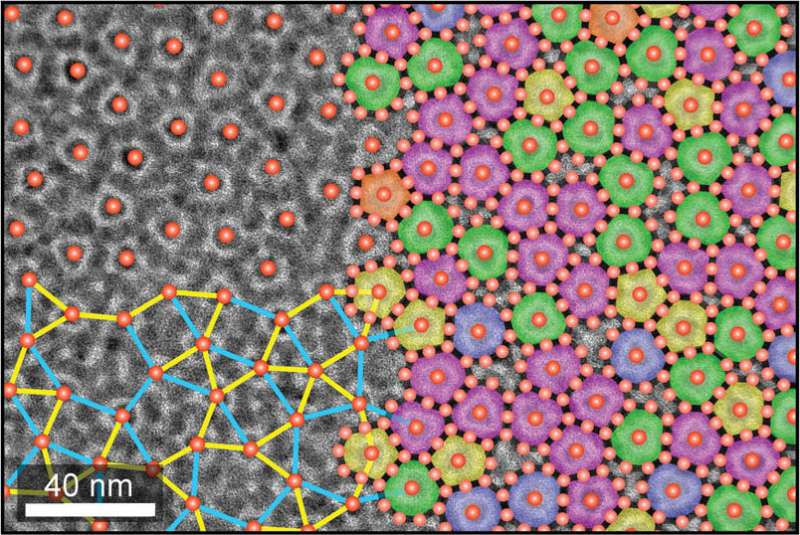

| Date | 20th, Dec 2018 |
|---|
 First discovered in the 1980s, quasicrystals have ordered structures that, unlike normal crystals, lack a predictable repeating pattern. Quasicrystals also have symmetries that are "forbidden" in normal crystals. Researchers from Brown University have demonstrated a new type of quasicrystal structure assembled from a single type of nanoparticle building blocks. Such a structure had been predicted mathematically but never before demonstrated. The image shows a non-repeating structure with 10-fold rotational symmetry. Credit: Chen lab / Brown University
First discovered in the 1980s, quasicrystals have ordered structures that, unlike normal crystals, lack a predictable repeating pattern. Quasicrystals also have symmetries that are "forbidden" in normal crystals. Researchers from Brown University have demonstrated a new type of quasicrystal structure assembled from a single type of nanoparticle building blocks. Such a structure had been predicted mathematically but never before demonstrated. The image shows a non-repeating structure with 10-fold rotational symmetry. Credit: Chen lab / Brown University
The strange class of materials known as quasicrystals has a new member. In a paper published on Thursday, Dec. 20, in Science, researchers from Brown University describe a quasicrystalline superlattice that self-assembles from a single type of nanoparticle building blocks.
This is the first definitive observation of a quasicrystalline superlattice formed from a single component, the researchers say. The discovery provides new insight into how these strange crystal-like structures can emerge.
"Single-component quasicrystal lattices have been predicted mathematically and in computer simulations, but hadn't been demonstrated before this," said Ou Chen, an assistant professor of chemistry at Brown and the paper's senior author. "It's a fundamentally new type of quasicrystal, and we've been able to figure out the rules for making it, which will be useful in the continued study of quasicrystal structures."
Quasicrystal materials were first discovered in the 1980s by the chemist Dan Shechtman, who in 2011 was awarded the Nobel Prize for the discovery. Unlike crystals, which consist of ordered patterns that repeat, quasicrystals are ordered but their patterns don't repeat. Quasicrystals also have symmetries that aren't possible in traditional crystals. Normal crystals, for example, can have three-fold symmetries that emerge from repeating triangles or four-fold symmetry from repeating cubes. Two- and six-fold symmetries are also possible. But quasicrystals can have exotic five-, 10- or 12-fold symmetries, all of which are "forbidden" in normal crystals.
The first quasicrystalline materials discovered were metal alloys, usually aluminum with one or more other metals. So far, these materials have found use as non-stick coatings for frying pans and anti-corrosive coatings for surgical equipment. But there's been much interest in making new types of quasicrystal materials—including materials made from self-assembling nanoparticles.
